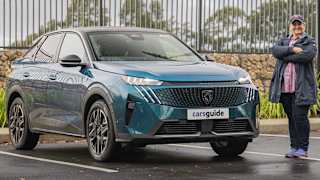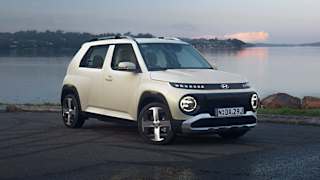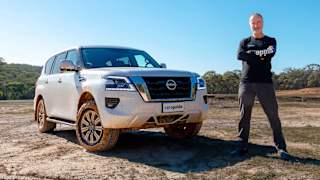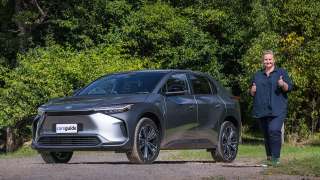So, with 432kW and around 1160Nm, even though the G580 weighs in at around three tonnes, you’re talking 0-100 km/h in 4.7 seconds. And this car gets up and goes… like a beast.
What you don’t get is that traditional Merc-AMG G63 V8 rumble, because, of course, no engine.
But you do get what Mercedes calls ‘G-Roar’, essentially a sound bar at the front of the car also using the audio system inside to give it what is not exactly an engine noise but some sense of the car progressing. And you can turn it off for completely silent running.
‘Electric Dynamic Select’ changes the parameters of the motors, transmission, suspension, ESP and steering as required. On-road that means ‘Comfort’, ‘Sport’ and ‘Individual’ modes, with off-road comprising ‘Trail’ and ‘Rock’. In the Comfort setting drive flows primarily to one axle for optimum energy efficiency.
Suspension is by double wishbones at the front and a De Dion-style live (rigid) axle at the rear. You’ve got the same adaptive-type set-up as per other G-Class models, so ‘Comfort’ and ‘Sport’ modes and of the many traditional G-Class traits this car exhibits, ride quality is one of them.
Even in Comfort you’ll find even little bumps and thumps making their way up into the seat of the pants and the cabin. It is after all a body-on-frame, ladder-chassis type vehicle and that’s not unusual.
In terms of steering, it’s accurate and road feel is good. You’ve got 275-wide Falken Azenis FK520 tyres that are more on- than off-road focused. The car feels stable and nicely planted on the road.
The physical brakes are by ventilated discs front and rear, and the big rotors are the same size (353mm) all around. They work nicely and feel like a conventional set-up.
Regenerative braking kicks in as soon as you lift off the accelerator pedal. The powertrain is harvesting energy as the car decelerates and there are four levels you can adjust with the steering wheel paddles up to a quite aggressive level - not quite, but close to a single-pedal set-up.
Off-road, the G580’s ‘G-Steering’ system allows the wheels to turn at different speeds to induce slight ‘drift-like’ oversteer and tighten the turning circle. It works beautifully and the car’s fording depth is 850mm, a full 150mm more than internal-combustion G-Class models.
A three-speed off-road crawl function is adjustable to speeds as low as 2.0km/h, and the car is claimed to remain stable on sideways slopes up to 35 degrees.
Torque vectoring is used to create ‘virtual diff locks’ and there’s a ‘low-range’ setting. Switch to the ‘Offroad Cockpit’ and data including gradient, lateral inclination, compass readings, tyre pressures and the selected G-Mode appear.
A ‘Transparent Bonnet’ function creates a virtual view of what’s approaching and passing under the front wheels to help the driver pick their way through steep ascents or declines.
For the record, the G580’s approach angle is 32 degrees, departure is 30.7, breakover is 20.3 and ground-clearance is 250mm.
And of course, with the wheels independently powered, the G580’s signature move is what Mercedes-Benz calls a ‘G-Turn’ but the rest of the world calls a tank turn.
If you encounter an obstacle that makes forward progress impossible, the system spins the left- and right-hand wheels in opposite directions so this brute can turn on the spot like an M1 Abrams. You can’t help but crack up laughing when executing this extreme party trick!
In terms of miscellaneous observations around ergonomics and the car in general, it has a 13.6-metre conventional turning circle. So if you’re not using the G Turn function in the car park be ready for a sizeable turning arc.
Also, those aero tweaks here and there seem to have had an effect. Wind noise, especially for such an upright, squared-off design is surprisingly modest. And overall, from a build point of view, this car feels as though it’s been carved from a solid piece of metal. In every aspect it presents as a quality item.






